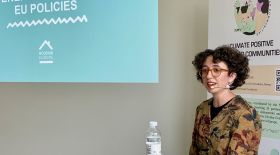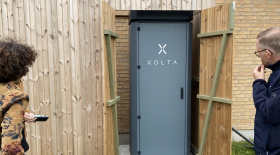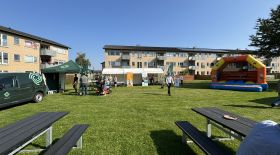Sønderborg, where innovative energy efficiency meets affordable housing and social inclusion
Paving the way for an inclusive green transition
27 September 2024 | Published in Social
On September 19 and 20, 2024, the community centre of SAB’s (Sønderborg Housing Association) became an innovation hub for the Danish social housing sector. The two-day event, co-organised by SAB, ProjectZero and Housing Europe as part of the EU-funded project ARV, aimed to showcase energy- and cost-efficient technical solutions for social housing and engage with tenants.
Sønderborg, located near Denmark’s border with Germany, is paving the way for an inclusive green transition, thanks to Green Deal ARV, H2020 EU-funded project aiming at creating climate positive circular communities in Europe and increasing the building renovation rate.
The large-scale demonstration project in Sønderborg is led by SAB (Sønderborg Housing Association - Salus Boligadministration) together with a well-knit team of frontrunners ProjectZero, Danfoss, DTU - Technical University of Denmark and Wygwam Danmark, a division of Niko to increase decentralisation renewable energy production and energy efficiency via low temperature district heating and smart home control systems.
The pilot activities are being rolled-out in SAB’s Department 22 (432 apartments) and 75 (38 homes in semi-detached houses). While the former is focused on reducing district heating return temperature from the radiator system in the apartments and water heaters via an innovative ‘after cooling principle’, the latter has installed a smart home lighting control system and is monitoring and forecasting energy demand. Both pilots are using solar PV panels with a shared storage system with flexibility functions.
Introducing demonstrated energy efficient measures in social housing connected to district heating networks
The seminar, moderated by Henrik Madsen from BL-Danmarks Almene Boliger, presented Sønderborg’s demonstration project to managers and technical staff from social housing associations in Denmark as well as district heating companies.
Professor Henrik Madsen from the Technical University of Denmark (DTU) emphasised the importance of data-driven methods and AI in optimizing heat demand and district heating systems. He discussed how digital models and data collection can improve energy efficiency and reduce costs.
Jan Eric Thorsen from Danfoss presented the Leanheat intelligent heating control system, an AI based software and control system applied as part of the smart control of the building’s heating system. A dynamic model that uses weather predictions and indoor temperature measurements to determine the optimal heating supply temperature without sacrificing comfort. It addresses the challenge of reducing uncontrolled heat losses and emissions, achieving 5-7% energy savings without compromising comfort.
In combination with the control system, the aftercooling concept is an innovative district heating substation for large multi-apartment buildings where the domestic hot water preparation and reheating of the circulation flows are decoupled and obtained in two separate heat exchangers connected in parallel. The concept provides a reduced return temperature to the district heating network.
’For example, aftercooling might be useful in departments where penalties are imposed for not cooling return water sufficiently before it goes back to the district heating company’, says Brian Skou Juhler Larsen, technical director at SALUS Housing Administration/Sønderborg Housing Association.
Jonas Duus Ranum from Niko-Servodan, Wygwam, presented energy-saving products and Smart Home solutions that allow residents to control their energy and heating consumption via an app on their phones, as well as a display in their homes.
‘Social housing represents 20 percent of Denmark’s housing stock, and there is a need to balance energy and climate ambitions with rent levels and housing affordability’ pointed Solveig Raaberg Tingey, deputy director of BL-Danmarks Almene Boliger.
Negotiations are underway in Denmark to stimulate the installation of solar panels, but Danish regulation is not helping. At the moment, profits from solar energy must revert into the grid, which involves additional costs such as tariffs. This complicates the negotiations, but there’s hope that the recently revised EU directives could offer a solution.
As highlighted by Clara Mafé, Innovation Officer at Housing Europe, the recently revised EU directives are pushing for more projects like Sønderborg’s. Particularly, the Energy Efficiency Directive (EED) and the Energy Performance of Buildings Directive (EPBD) indicate that after 2030 district heating for new buildings will only be allowed under certain criteria related to the progressive greening of the energy source.
The Social Climate Fund (SCF), a financial mechanism that aims to aims to address the social and distributional impact of the new emissions trading system for buildings and road transport, provides a window of opportunity to continue investing in efficient district heating systems in social housing. schemes promoting green energy and energy-efficient solutions in social housing.
Demonstrations and field trips
After lunch, participants had the opportunity to inspect two demonstration projects: a visit to Damsmosevej to see the Niko Smart Home System and solar and battery systems, and an excursion to Hvedemarken to see Danfoss’ aftercooling system and battery setup.
At Damsmosevej, 367m² of solar panels and a 30-kWh battery system were installed, covering about 40% of the electricity consumption for the 38 homes, along with a Smart Home system for managing energy and heating, as part of the ARV project. The system has been installed in 19 of the 38 homes, and within a year, it will be possible to see if energy consumption has decreased in the selected homes compared to the remaining 19 homes.
Kløver- and Hvedemarken are equipped with 3,000m² of solar panels and a 290-kWh battery system, which in 2023 covered 36% of electricity costs and significantly reduced energy expenses, along with Danfoss' innovative aftercooling system that utilises excess heat from the solar panels for heating. Participants gained practical insights into how these solutions work and contribute to a greener housing sector.
Raising tenants’ awareness about energy consumption at home
Residents’ involvement and behaviour is key to help reduce heating consumption at home. ProjectZero, a public-private partnership between Sønderborg Municipality and the Bitten & Mads Clausens Foundation dedicated to make Sønderborg’s energy system carbon-neutral by 2029, is supporting the social housing company in this process.
The average apartment in SAB Department 22 has two occupants, with diverse demographics, including rents ranging from 2500 DKK (335 EUR) to 7500 DKK (1000 EUR), ages and different ethnicities. Most residents don’t focus much on their heating, as long as it works, but more are now paying attention thanks to the digital system. ProjectZero aims to increase residents' involvement and interest in their consumption habits by providing insights into their heat usage through a digital system called Brunata, allowing them to monitor their consumption.
Anne Branderup from ProjectZero demonstrated what residents can view in the Brunata app, which not only helps them track their usage and but also communicate with the housing association’s staff. This improves dialogue and service. Staff have also been trained in the tool. She noted that educating residents and generating interest is time-consuming, especially since people move in and out, making it an ongoing effort.
On September 20, activities continued with a special event for residents and citizens of Sønderborg led by Project Zero, including various practical advice and educational activities on energy efficiency and sustainability.
From getting up close to solar panels, adjusting thermostats, and exploring apps that monitor consumption, to learning more about waste sorting— an ice cream track and bouncy castles for children where put and Danish Energy Agency and SONFOR were available to advice on how to make a better use of energy and waste at home.
It was an afternoon filled with learning, laughter, and high spirits. Resident interest is crucial for the shared goal of creating energy-efficient solutions and contributing to a better climate
Housing Europe is working to promote sustainable solutions and energy optimisation in the social housing sector through stakeholder engagement events as part of the ARV project, to create a for knowledge-sharing space to transfer and upscale innovation.
Sønderborg sets a great example of how to balance decarbonisation with the need to ensure affordable housing and social equity for the new and first-ever EU Commissioner for Energy and Housing, Dan Jørgensen.
To see more of Sønderborg and other projects’ demonstrated solutions for district-scale renovation, visit the e-marketplace.



